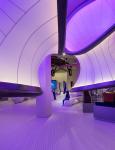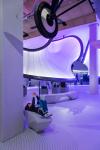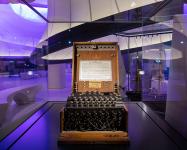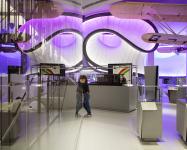Mathematics: The Winton Gallery brings together remarkable stories, historical artefacts and design to highlight the central role of mathematical practice in all our lives, and explores how mathematicians, their tools and ideas have helped build the modern world over the past four centuries.
More than 100 treasures from the Science Museum’s world-class science, technology, engineering and mathematics collections have been selected to tell powerful stories about how mathematics has shaped, and been shaped by, some of our most fundamental human concerns – from trade and travel to war, peace, life, death, form and beauty.
Curator Dr David Rooney said, “At its heart this gallery reveals a rich cultural story of human endeavour that has helped transform the world over the last four hundred years. Mathematical practice underpins so many aspects of our lives and work, and we hope that bringing together these remarkable stories, people and exhibits will inspire visitors to think about the role of mathematics in a new light.”
Positioned at the centre of the gallery is the Handley Page ‘Gugnunc’ aeroplane, built in 1929 for a competition to construct safe aircraft. Ground-breaking aerodynamic research influenced the wing design of this experimental aeroplane, helping to shift public opinion about the safety of flying and to secure the future of the aviation industry. This aeroplane encapsulates the gallery’s overarching theme, illustrating how mathematical practice has helped solve real-world problems and in this instance paved the way for the safe passenger flights that we rely on today.
Mathematics also defines Zaha Hadid Architects’ enlightening design for the gallery. Inspired by the Handley Page aircraft, the design is driven by equations of airflow used in the aviation industry. The layout and lines of the gallery represent the air that would have flowed around this historic aircraft in flight, from the positioning of the showcases and benches to the three-dimensional curved surfaces of the central pod structure.
Mathematics: The Winton Gallery is the first permanent public museum exhibition designed by Zaha Hadid Architects anywhere in the world. The gallery is also the first of Zaha Hadid Architects’ projects to open in the UK since Dame Zaha Hadid’s sudden death in March 2016. The late Dame Zaha first became interested in geometry while studying mathematics at university. Mathematics and geometry have a strong connection with architecture and she continued to examine these relationships throughout each of her projects; with mathematics always central to her work. As Dame Zaha said, “When I was growing up in Iraq, math was an everyday part of life. We would play with math problems just as we would play with pens and paper to draw – math was like sketching.”
Ian Blatchford, Director of the Science Museum Group, said, “We were hugely impressed by the ideas and vision of the late Dame Zaha Hadid and Patrik Schumacher when they first presented their design for the new mathematics gallery over two years ago. It was a terrible shock for us all when Dame Zaha died suddenly in March this year, but I am sure that this gallery will be a lasting tribute to this world-changing architect and provide inspiration for our millions of visitors for many years to come.”
From a beautiful 17th century Islamic astrolabe that uses ancient mathematical techniques to map the night sky, to an early example of the famous Enigma machine, designed to resist even the most advanced mathematical techniques for code breaking during the Second World War, each historic object within the gallery has an important story to tell. Archive photography and film helps to capture these stories, and introduces the wide range of people who made, used or were impacted by each mathematical device or idea.
Some instruments and objects within the gallery clearly reference their mathematical origin. Others may surprise visitors and appear rooted in other disciplines, from classical architecture to furniture design. Visitors will see a box of glass eyes used by Francis Galton in his 1884 Anthropometric Laboratory to help measure the physical characteristics of the British public and develop statistics to support a wider social and political movement he termed ‘eugenics’. On the other side of the gallery is the pioneering Wisard pattern-recognition machine built in 1981 to attempt to re-create the ‘neural networks’ of the brain. This early Artificial Intelligence machine worked, until 1995, on a variety of projects, from banknote recognition to voice analysis, and from foetal growth monitoring in hospitals to covert surveillance for the Home Office.
2014
2016
Size: 913m²
Architect: Zaha Hadid Architects
Design: Zaha Hadid and Patrik Schumacher
Project Director: Charles Walker
Project Senior Associate: Bidisha Sinha
Project Associate: Shajay Bhooshan
Project Team: Vishu Bhooshan, Henry Louth, David Reeves, Nhan Vo, Mattia Santi, Sai Prateik Bhasgi, Karthikeyan Arunachalam, Tommaso Casucci, Marko Margeta, Filippo Nassetti, Mostafa El Sayed, Suryansh Chandra, Ming Cheong, Carlos Parraga-Botero, Ilya Pereyaslavtsev, Ramon Weber
Competition Team: Shajay Bhooshan, Mostafa El Sayed, Suryansh Chandra, Vishu Bhooshan, Henry David Louth, Weber Ramon Elias
Mathematics: The Winton Gallery by Zaha Hadid in United Kingdom won the WA Award Cycle 25. Please find below the WA Award poster for this project.
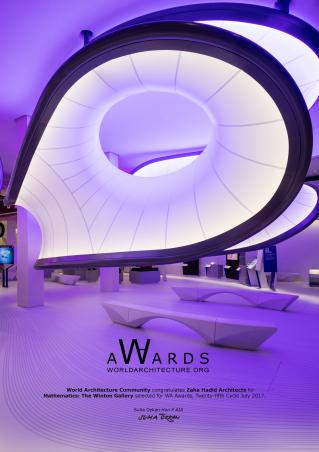
Downloaded 51 times.
Favorited 3 times







